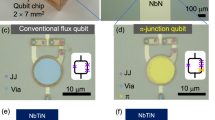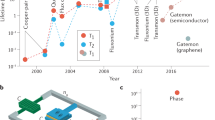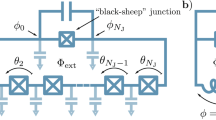Abstract
High operation speed and low energy consumption may allow the superconducting digital single-flux-quantum circuits to outperform traditional complementary metal–oxide–semiconductor logic. The remaining major obstacle towards high element densities on-chip is a relatively large cell size necessary to hold a magnetic flux quantum Φ0. Inserting a π-type Josephson junction1,2 in the cell is equivalent to applying flux Φ0/2 and thus makes it possible to solve this problem3. Moreover, using π-junctions in superconducting qubits may help to protect them from noise4,5. Here we demonstrate the operation of three superconducting circuits—two of them are classical and one quantum—that all utilize such π-phase shifters realized using superconductor/ferromagnet/superconductor sandwich technology6. The classical circuits are based on single-flux-quantum cells, which are shown to be scalable and compatible with conventional niobium-based superconducting electronics. The quantum circuit is a π-biased phase qubit, for which we observe coherent Rabi oscillations. We find no degradation of the measured coherence time compared to that of a reference qubit without a π-junction.
This is a preview of subscription content, access via your institution
Access options
Subscribe to this journal
Receive 12 print issues and online access
$259.00 per year
only $21.58 per issue
Buy this article
- Purchase on SpringerLink
- Instant access to full article PDF
Prices may be subject to local taxes which are calculated during checkout




Similar content being viewed by others
References
Bulaevskii, L. N., Kuzii, V. V. & Sobyanin, A. A. Superconducting system with weak coupling to the current in the ground state. J. Exp. Theor. Phys. Lett. 25, 290–294 (1977).
Buzdin, A. I., Bulaevskij, L. N. & Panyukov, S. V. Critical-current oscillations as a function of the exchange field and thickness of the ferromagnetic metal (F) in an S–F–S Josephson junction. J. Exp. Theor. Phys. Lett. 35, 178–180 (1982).
Ustinov, A. V. & Kaplunenko, V. K. Rapid single-flux quantum logic using π-shifters. J. Appl. Phys. 94, 5405–5407 (2003).
Ioffe, L. B., Geshkenbein, V. B., Feigelman, M. V., Fauchère, A. L. & Blatter, G. Environmentally decoupled sds-wave Josephson junctions for quantum computing. Nature 398, 679–681 (1999).
Blatter, G., Geshkenbein, V. B. & Ioffe, L. B. Design aspects of superconducting-phase quantum bits. Phys. Rev. B 63, 174511 (2001).
Ryazanov, V. V. et al. Coupling of two superconductors through a ferromagnet: Evidence for a π-junction. Phys. Rev. Lett. 86, 2427–2430 (2001).
Van Harlingen, D. J. Phase-sensitive tests of the symmetry of the pairing state in the high-temperature superconductors—evidence for d x 2 − y 2 symmetry. Rev. Mod. Phys. 67, 515–535 (1995).
Baselmans, J. J. A., Morpurgo, A. F., van Wees, B. & Klapwijk, T. M. Reversing the direction of supercurrent in a controllable Josephson junction. Nature 397, 43–45 (1999).
Testa, G. et al. Midgap state-based π-junctions for digital applications. Appl. Phys. Lett. 85, 1202–1204 (2004).
Hilgenkamp, H. et al. Ordering and manipulation of the magnetic moments in large-scale superconducting π-loop arrays. Nature 422, 50–53 (2003).
Cleuziou, J-P., Wernsdorfer, W., Bouchiat, V., Ondarcuhu, T. & Monthioux, M. Carbon nanotube superconducting quantum interference device. Nature Nanotech. 1, 53–59 (2006).
Terzioglu, E. & Beasley, M. R. Complementary Josephson junction devices and circuits: A possible new approach to superconducting electronics. IEEE Trans. Appl. Supercond. 8, 48–53 (1998).
Buzdin, A. I. Proximity effects in superconductor–ferromagnet heterostructures. Rev. Mod. Phys. 77, 935–976 (2005).
Frolov, S. M. et al. Imaging spontaneous currents in superconducting arrays of π-junctions. Nature Phys. 4, 32–36 (2008).
Ryazanov, V. V., Oboznov, V. A., Veretennikov, A. V. & Rusanov, A. Y. Intrinsically frustrated superconducting array of superconductor–ferromagnet–superconductor π junctions. Phys. Rev. B 65, 020501 (2001).
Frolov, S. M., Van Harlingen, D. J., Oboznov, V. A., Bolginov, V. V. & Ryazanov, V. V. Measurement of the current–phase relation of superconductor/ferromagnet/superconductor π Josephson junctions. Phys. Rev. B 70, 144505 (2004).
Oboznov, V. A., Bolginov, V. V., Feofanov, A. K., Ryazanov, V. V. & Buzdin, A. I. Thickness dependence of the Josephson ground states of superconductor–ferromagnet–superconductor junctions. Phys. Rev. Lett. 96, 197003 (2006).
Likharev, K. K. & Semenov, V. K. RSFQ logic/memory family: A new Josephson-junction technology for sub-terahertz-clock-frequency digital systems. IEEE Trans. Appl. Supercond. 1, 3–28 (1991).
Ortlepp, T. et al. Flip-flopping fractional flux quanta. Science 312, 1495–1497 (2006).
Majer, J. B., Butcher, J. R. & Mooij, J. E. Simple phase bias for superconducting circuits. Appl. Phys. Lett. 80, 3638–3640 (2002).
Balashov, D. et al. Passive phase shifter for superconducting Josephson circuits. IEEE Trans. Appl. Supercond. 17, 142–145 (2007).
Mélin, R. sin(2ϕ) current–phase relation in SFS junctions with decoherence in the ferromagnet. Europhys. Lett. 69, 121–127 (2005).
Hikino, S., Mori, M., Takahashi, S. & Maekawa, S. Ferromagnetic resonance induced Josephson current in a superconductor/ferromagnet/superconductor junction. J. Phys. Soc. Jpn 77, 053707 (2008).
Simmonds, R. W. et al. Decoherence in Josephson phase qubits from junction resonators. Phys. Rev. Lett. 93, 077003 (2004).
Chiorescu, I., Nakamura, Y., Harmans, C. J. P. M. & Mooij, J. E. Coherent quantum dynamics of a superconducting flux qubit. Science 299, 1869–1871 (2003).
Lisenfeld, J., Lukashenko, A., Ansmann, M., Martinis, J. M. & Ustinov, A. V. Temperature dependence of coherent oscillations in Josephson phase qubits. Phys. Rev. Lett. 99, 170504 (2007).
Kato, T., Golubov, A. A. & Nakamura, Y. Decoherence in a superconducting flux qubit with a π-junction. Phys. Rev. B 76, 172502 (2007).
Weides, M. et al. 0–π Josephson tunnel junctions with ferromagnetic barrier. Phys. Rev. Lett. 97, 247001 (2006).
Bannykh, A. A. et al. Josephson tunnel junctions with a strong ferromagnetic interlayer. Phys. Rev. B 79, 054501 (2009).
Burmistrov, E. V. et al. A planar picoamperemeter based on a superconducting quantum interferometer. J. Commun. Technol. Electr. 51, 1319–1324 (2006).
Acknowledgements
This work was supported by the EU projects EuroSQIP and MIDAS. We acknowledge support by the Deutsche Forschungsgemeinschaft (DFG), the joint grant of DFG and Russian Foundation of Basic Research, the Russian Federal Agency of Science and Innovations, and the State of Baden–Württemberg through the DFG Center for Functional Nanostructures (CFN).
Author information
Authors and Affiliations
Contributions
A.K.F., V.A.O., V.V.R., A.B.Z. and A.V.U. contributed with ideas for the experiments. A.K.F., V.A.O., V.V.B., J.L., M.K., D.B. and V.P.K. designed samples. V.A.O., A.N.R., M.K., D.B. and P.N.D. fabricated samples. A.K.F., V.V.B., V.A.O., J.L., S.P., M.K. and D.B. carried out experiments and analysed the experimental data. A.K.F. made theoretical estimations. A.V.U., J.L., V.V.R. and A.B.Z. did most of the writing. All of the authors discussed the results and the manuscript extensively.
Corresponding author
Ethics declarations
Competing interests
The authors declare no competing financial interests.
Supplementary information
Supplementary Information
Supplementary Information (PDF 208 kb)
Rights and permissions
About this article
Cite this article
Feofanov, A., Oboznov, V., Bol’ginov, V. et al. Implementation of superconductor/ferromagnet/ superconductor π-shifters in superconducting digital and quantum circuits. Nature Phys 6, 593–597 (2010). https://doi.org/10.1038/nphys1700
Received:
Accepted:
Published:
Issue date:
DOI: https://doi.org/10.1038/nphys1700
This article is cited by
-
Addressable superconductor integrated circuit memory from delay lines
Scientific Reports (2023)
-
Superconducting quantum interference at the atomic scale
Nature Physics (2022)
-
Tailoring the superradiant and subradiant nature of two coherently coupled quantum emitters
Nature Communications (2022)
-
Quantum error correction of spin quantum memories in diamond under a zero magnetic field
Communications Physics (2022)
-
Coexistence and tuning of spin-singlet and triplet transport in spin-filter Josephson junctions
Communications Physics (2022)



